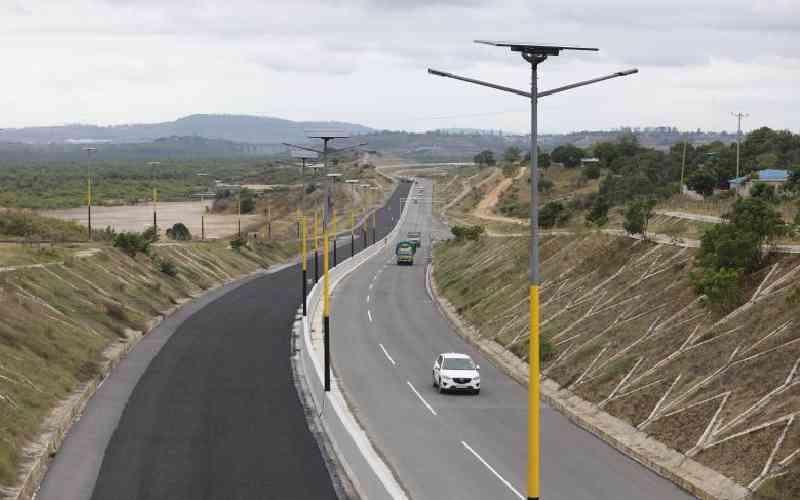By Winsley Masese
Nairobi, Kenya: The construction of Nairobi’s Sh17 billion Southern Bypass Road is proceeding on schedule with the opening of the Kibera-Dagoretti section set for July.
The opening of the section is expected to ease the flow of traffic within the southern parts of the city. Last week, top Kenyan and Chinese government officials toured the project following the visit to Kenya by Chinese Premier Li Keqiang, which saw the signing of a number of commercial agreements between the two countries. The project is one of the ventures being undertaken by a Chinese firm in Kenya.
“We are proceeding on schedule. I see us meeting all key thresholds and delivering this project on time,” said Shu Yili, project leader with the contractor China Road and Bridge Corporation (CRBC).
During the tour, Transport and Infrastructure Cabinet Secretary Michael Kamau was accompanied by the Principal Secretary for Infrastructure Eng John Mosonik, PS for Transport, Nduva Muli and the two visiting Presidents of Exim Bank of China, Li Ruogu and Chen Fenjian of China Communications Company (CCCC). CCCC is the parent company of the southern bypass contractor, CRBC.
Exim Bank of China has financed 85 per cent of the Southern Bypass project, which is scheduled for completion in 2015 while the remaining component will be borne by the Government of Kenya.
Already, the Southern Bypass link is 55per cent complete, with the section between Kibera and Dagoretti nearing completion and the expected commissioning of the same slated for July this year.
Substantive work has been done on the segment to Alliance High School, some 21 culverts and three bridges have been completed while intensive earthwork is going on within Kikuyu, township, Ngong, Dagoretti and Mombasa Road interchanges. The Dagoretti-Kikuyu section is expected to be ready for traffic by December. The project, which is being implemented by CRBC under the supervision of Kenya National Highways Authority (KeNHA), entails the construction of a 28.6 kilometre dual carriageway, with two lanes in each direction. Other key features include 12 kilometre slip roads and 8.5 kilometre service roads, four modern interchanges and street lighting.
Once-moribund
Starting on Mombasa Road near Ole Sereni Hotel, it joins the Mombasa-Kisumu road, the country’s main thoroughfare at Kikuyu. It crosses the National Park westward then goes through Lang’ata Road, Ngong Road, Motoine River, Dagoretti Road Thogoto Road then passes over Ondiri River and a railway line towards Kikuyu town.
The road is meant to reduce congestion within the Nairobi Central Business District by providing an alternative route to motorists going to western Kenya and other destinations west of the capital city. Once the road is commissioned, it is hoped that such drivers will not have to drive through the city. The construction of the Southern Bypass, which started in 2012 follows a trend in which the Government is increasingly relying on bypass roads (such as Northern Bypass), the opening up of once-moribund link roads and the heavy use of interchanges as a key feature of road design to reduce traffic gridlock in Nairobi and some of the country’s main cities.
Even then, the project has not been without its challenges, the major one being delays in the acquisition of certain pieces of land critical to the smooth implementation of the project. These include a part of the Nairobi National Park, whose excision has been stayed by a court decision and a part of forest land needed for the Ngong Interchange, with the latter greatly diminishing the land available to contactor for operations.
De-gazettement of the relevant portion of the national park by Parliament is a desirable outcome. There are minimum safety distance required by Kenya Civil Aviation Regulations that stipulate any development adhere to and this has necessitated the road to curve into some section at the Northern edge of the Nairobi National Park at the Wilson Airport location.
 The Standard Group Plc is a
multi-media organization with investments in media platforms spanning newspaper
print operations, television, radio broadcasting, digital and online services. The
Standard Group is recognized as a leading multi-media house in Kenya with a key
influence in matters of national and international interest.
The Standard Group Plc is a
multi-media organization with investments in media platforms spanning newspaper
print operations, television, radio broadcasting, digital and online services. The
Standard Group is recognized as a leading multi-media house in Kenya with a key
influence in matters of national and international interest.
 The Standard Group Plc is a
multi-media organization with investments in media platforms spanning newspaper
print operations, television, radio broadcasting, digital and online services. The
Standard Group is recognized as a leading multi-media house in Kenya with a key
influence in matters of national and international interest.
The Standard Group Plc is a
multi-media organization with investments in media platforms spanning newspaper
print operations, television, radio broadcasting, digital and online services. The
Standard Group is recognized as a leading multi-media house in Kenya with a key
influence in matters of national and international interest.








